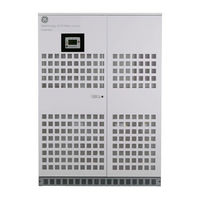GE SG SERIES 40 Manuals
Manuals and User Guides for GE SG SERIES 40. We have 2 GE SG SERIES 40 manuals available for free PDF download: Installation Manual, Operating Manual
GE SG SERIES 40 Installation Manual (635 pages)
Table of Contents
-
-
Layout9
-
Installation11
-
Transport11
-
Delivery12
-
Storage12
-
UPS Location13
-
Unpacking17
-
Notes46
-
Notes Form46
-
Section 2
51-
Safety Rules53
-
Layout56
-
Introduction58
-
Description59
-
Load Sharing63
-
Lcd Screen68
-
Alarms72
-
Parameters73
-
Edit Mode75
-
Alarms List81
-
Operation88
-
Options125
-
Maintenance127
-
Service Check127
-
Battery128
-
Notes129
-
Notes Form129
-
-
Section 3
134-
Layout138
-
Installation139
-
Transport139
-
Delivery140
-
Storage140
-
UPS Location141
-
Battery Location143
-
Unpacking145
-
Serial Port J3164
-
Notes167
-
Notes Form167
-
Section 4
172-
Introduction177
-
Description178
-
Operation Modes179
-
Automatic Bypass180
-
Manual Bypass180
-
Load Sharing182
-
Synchronization182
-
System Control182
-
Layout185
-
Control Panel186
-
Lcd Screen188
-
Metering Mode189
-
Alarms192
-
Parameters193
-
Edit Mode195
-
User Parameters198
-
Alarms List201
-
Messages List205
-
Operation208
-
Options245
-
Battery247
-
Maintenance247
-
Service Check247
-
Notes249
-
Notes Form249
-
Section 5
254-
Layout258
-
Installation259
-
Transport259
-
Delivery260
-
Storage260
-
UPS Location261
-
Battery Location263
-
Unpacking265
-
Notes286
-
Notes Form286
-
Section 6
291-
Introduction296
-
Description297
-
Operation Modes298
-
Automatic Bypass299
-
Manual Bypass299
-
Load Sharing301
-
Synchronization301
-
System Control301
-
Layout304
-
Control Panel305
-
Lcd Screen307
-
Metering Mode308
-
Alarms311
-
Parameters312
-
Edit Mode314
-
User Parameters317
-
Alarms List320
-
Messages List324
-
Operation327
-
Options364
-
Battery366
-
Maintenance366
-
Service Check366
-
Notes368
-
Notes Form368
-
Section 7
373-
Layout377
-
Installation378
-
Transport378
-
Delivery379
-
Storage379
-
UPS Location380
-
Battery Location382
-
Unpacking384
-
Notes408
-
Notes Form408
-
Section 8
413-
Layout418
-
Introduction419
-
Description420
-
Operation Modes421
-
Automatic Bypass423
-
Load Sharing425
-
Synchronization425
-
System Control425
-
Control Panel428
-
Home Screen431
-
Lcd Screen431
-
Metering433
-
Alarms436
-
Alarms List437
-
Messages List441
-
Setup445
-
Commands451
-
Operation452
-
Options483
-
Maintenance485
-
Service Check485
-
Battery486
-
Notes487
-
Notes Form487
-
Section 9
508-
Layout512
-
Installation514
-
Transport514
-
Delivery517
-
Storage517
-
UPS Location518
-
Battery Location520
-
Unpacking522
-
Notes552
-
Notes Form552
-
Section 10
557-
Layout562
-
Introduction563
-
Description564
-
Operation Modes565
-
Automatic Bypass567
-
Load Sharing569
-
Synchronization569
-
System Control569
-
Control Panel572
-
Home Screen575
-
Lcd Screen575
-
Metering577
-
Alarms580
-
Alarms List581
-
Messages List585
-
Setup590
-
Commands595
-
Operation596
-
Options619
-
Maintenance621
-
Service Check621
-
Battery622
-
Notes623
-
Notes Form623
Advertisement
GE SG SERIES 40 Operating Manual (88 pages)
10, 20, 30 and 40 kVA
Table of Contents
-
-
4 Layout
18 -
6 Lcd Screen
22-
Alarms26
-
Parameters27
-
Edit Mode29
-
7 Operation
42 -
9 Options
83 -
11 Notes
87-
Notes Form87
-
Advertisement

